As the eyes of the world were focused on the pomp and circumstance of Barack Obama moving into a new role as President of the United States, Obama’s Web team was hard at work – with far less fanfare – moving their Web property to a new address: whitehouse.gov, the official Web site for the President. And while, at first blush, the site may appear similar to Obama’s President-elect site, change.gov, it is strikingly different than the predecessors who have occupied whitehouse.gov over the past 12 years. How different? Let’s take a look.

Humble Beginnings
Whitehouse.gov was originally launched in October 1994 during the first Clinton administration. However, the earliest version of whitehouse.gov held in the Internet Archive Wayback Machine is dated December 27, 1996.
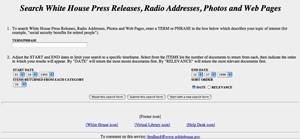
At that time, whitehouse.gov – which no doubt looked just fine in Mosaic – was rather sparse and, ironically, Google-like, providing a search function that allowed users to find Presidential press releases, radio addresses, photos, and Web pages.
By mid-1997, the site had abandoned its search functionality in favor of a list of hypertext links. Available resources included the aforementioned press releases and radio addresses, as well as executive orders.
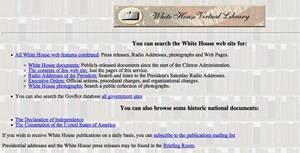
For context, the site also provided links to The Declaration of Independence and The Constitution of the United States of America.
Glimmers of Change
As the site supported the second Clinton administration and weathered the infamous whitehouse.com debacle – where visitors seeking the President found an NSFW adult site instead – it remained fairly static.
In late 1998, however, whitehouse.gov went through another major change – this time opting for more of an early Yahoo! aesthetic. In an effort to provide more information to the growing number of people on the Web, the site began to add more and more links to information sources, including an “Interactive Citizens’ Handbook,” “Commonly Requested Federal Services,” and breaking news. This version of whitehouse.gov also marked the appearance of “White House for Kids,” a section of the site focused on explaining the presidency to the younger set and “helping young people become more active and informed citizens.”

Regrettably, this version of the site also featured the “waving flag” animated gif which would continue to plague Web pages across the United States for years to come.
Navigating Whitehouse.gov
As the administration of George W. Bush took residence at whitehouse.gov in 2001, the site began to show signs of more structure. Most notably, introducing a left navigation for accessing static content, a design choice that opened the main page up to more specific and timely links. This version of the site also marks the introduction of accessibility at whitehouse.gov, allowing users to bypass the image-based site for a text-only version.
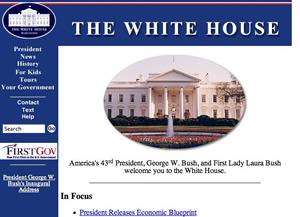
Focusing on the Latest News
Following the terrorist attacks in September 2001, whitehouse.gov went through a substantial design change that would remain in place for most the Bush presidency. Over the next few years, the home page of the post 9/11 version of the site grew more and more focused on breaking news summaries, current threat levels, and areas of focus.
Throughout this version, the navigation structure became more and more complex, introducing a more detailed left navigation as well as a top navigation structure. Also of note, Spanish-speaking users were given the opportunity to access some of the information in their native tongue.
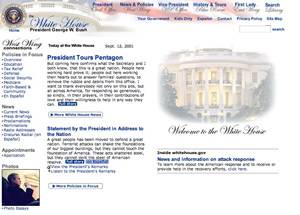
By 2003, whitehouse.gov began to resemble a modern news portal, providing short snippets of information with links to the “full story,” informational graphics, and the introduction of “Ask the White House,” an online form which allowed citizens to “submit questions to Bush administration officials.”
The design of whitehouse.gov remained fairly similar – with minor tweaks – throughout 2006. The only addition of note was the opportunity to subscribe to an RSS feed.
Major Design Overhaul
No doubt feeling the pressure from the growing maturity of Web design and the Web-browsing public, the Bush administration launched its last major redesign in 2007.
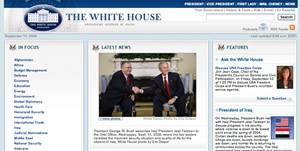
The last version of the site for the Bush presidency abandoned the portal feel for a more aesthetic presentation of information and links. This version of whitehouse.gov also featured a simplified top navigation structure and a more prominent search function. The RSS feed was moved the top of the page along with podcasts.
Obama Takes Over
And that brings us to 12:01 EST on January 20, 2009 when – riding the momentum of change.gov, Obama’s transition site – Macon Phillips, the newly appointed New Media Director for the Obama administration, introduced the new whitehouse.gov.
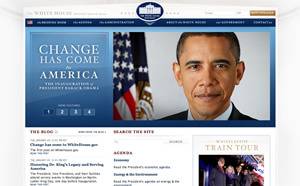
With an obvious nod to both the latest communications methods and the latest aesthetic, the new site offers a blog with a conversational tone, a number of RSS feeds (NOTE: We’ve added all of the feeds – six at last count – into one whitehouse.gov RSS feed, if you’d like to follow it), and it validates to XHTML 1.0 Transitional.
One noticeably absent component – at least in our cursory overview of the site – is the Intense Debate comment feature of which we had been so fond on the change.gov site.
What’s Next for Whitehouse.gov?
So there you have it. A short visual history of the home page of the President of the US. Having managed transitions through through three leaders – not to mention Web 1.0 and Web 2.0 – the site continues to improve the communications between the Executive Branch and its constituency.
If you’re interested in more versions of the site, please visit the Wayback Machine.
What’s next? That’s anyone’s guess. But you’ve likely got some ideas on how whitehouse.gov could be improved. What features would you suggest for the next version? We’d love to hear them.










